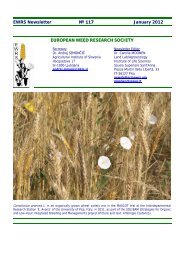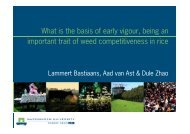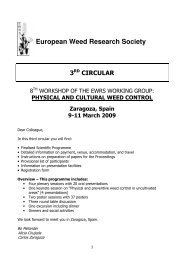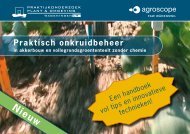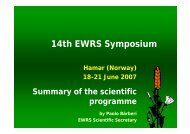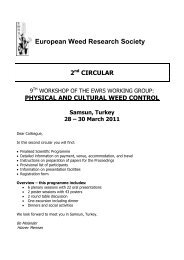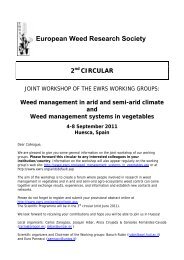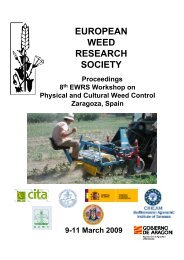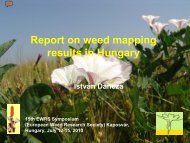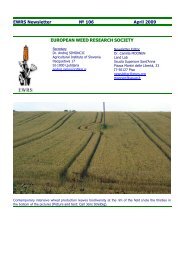Physical and Cultural Weed Control Working Group of - European ...
Physical and Cultural Weed Control Working Group of - European ...
Physical and Cultural Weed Control Working Group of - European ...
You also want an ePaper? Increase the reach of your titles
YUMPU automatically turns print PDFs into web optimized ePapers that Google loves.
9 th EWRS Workshop on <strong>Physical</strong> <strong>and</strong> <strong>Cultural</strong> <strong>Weed</strong> <strong>Control</strong> 65<br />
Samsun, Turkey, 28 – 30 March 2011<br />
Effect <strong>of</strong> flame weeding at different time intervals before crop emergence<br />
D. Hansson <strong>and</strong> S-E. Svensson<br />
Swedish University <strong>of</strong> Agricultural Sciences, P.O. Box 104, SE–230 53 Alnarp, Sweden. Email:<br />
David.Hansson@slu.se<br />
A research project studying ‘Effective weed management in row-grown organic carrots’ was<br />
carried out at SLU Alnarp. The project used a slightly modified form <strong>of</strong> the ‘participatory research’<br />
concept, which meant that it was associated with a reference group consisting <strong>of</strong> the growers<br />
participating in the project, advisors <strong>and</strong> researchers. The aim <strong>of</strong> the project was to examine various<br />
weed control methods combined into entire weed management strategies. After discussions with the<br />
growers in the group, the studies focused on weed control measures to be carried out before crop<br />
emergence, since these measures were considered to be the most important in the weed management<br />
strategy.<br />
One experiment carried out in Karlskrona, in the county <strong>of</strong> Blekinge in southern Sweden<br />
studied the importance <strong>of</strong> weed flaming shortly before the emergence <strong>of</strong> an organic carrot crop. The<br />
experiment included four replicates <strong>and</strong> examined four different times <strong>of</strong> flaming treatment in<br />
relation to the seeding date. The field in which the experiment was carried out was tilled with a<br />
rotary power harrow on 16 May <strong>and</strong> the carrot crop was sown on 27 May. <strong>Weed</strong> flaming was<br />
performed 5, 6, 7 <strong>and</strong> 9 days after sowing. The first carrot plants began to emerge from the soil 7 days<br />
after sowing. The plots were weeded by h<strong>and</strong> 29 days after sowing.<br />
The results showed that the number <strong>of</strong> weeds in the carrot crop decreased by 10% <strong>and</strong> the<br />
manual weeding requirement was reduced by 10-15 hours per hectare for every day flaming was<br />
delayed in relation to carrot emergence. <strong>Weed</strong> flaming one day too early increased the cost <strong>of</strong> manual<br />
weeding by SEK 2600 per hectare (approx. € 280 per hectare). The optimal conditions for successful<br />
weed flaming were found to be careful seedbed preparation, resulting in an even soil surface, <strong>and</strong><br />
sowing in a moist seedbed, resulting in simultaneous <strong>and</strong> uniform emergence <strong>of</strong> weeds <strong>and</strong><br />
cultivated plants.<br />
It was concluded that it is important to flame as late as possible before crop emergence. The optimal<br />
time is just before crop emergence, or when a few percent <strong>of</strong> the carrot plants have emerged. Losses<br />
in crop plant numbers due to planned late flaming relative to emergence can be compensated for by<br />
slightly increasing the seed rate.



